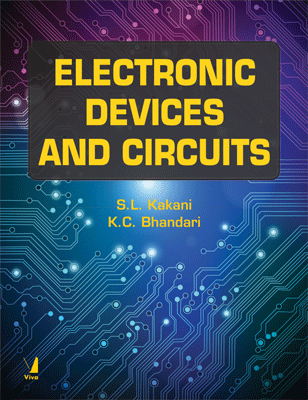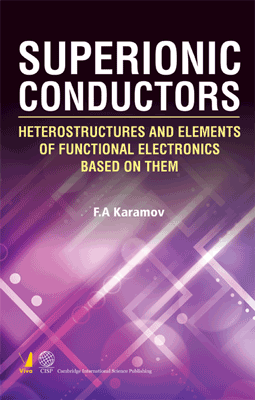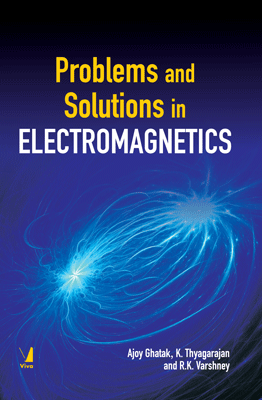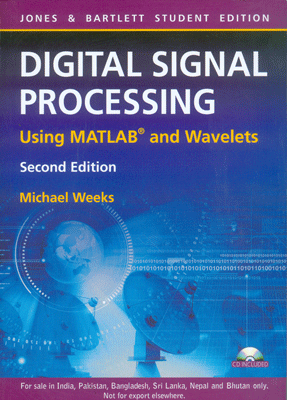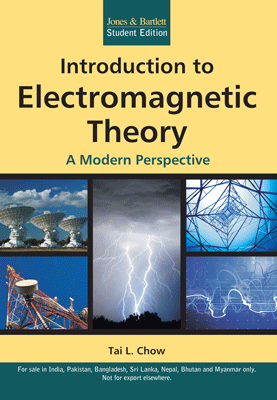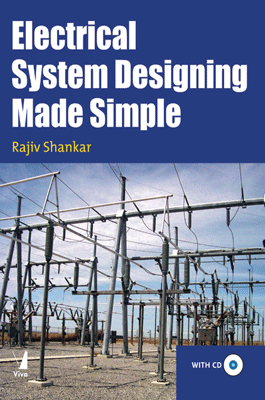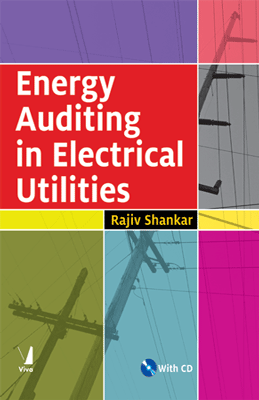Electronic Devices and Circuits
Electronic Devices and Circuits
₹715.50 ₹795.00 Save: ₹79.50 (10%)
Go to cartISBN: 9788130917726
Bind: Paperback
Year: 2014
Pages: 1136
Size: 172 x 242 mm
Publisher: Viva Books Originals
Sales Territory: Worldwide
Free MCQs with Solution Booklet
Description:
This comprehensive text is developed for B.Tech., B.Sc. (Hons. electronics). M.Sc. (electronics), Diploma, AMIE, etc. provides a sound basis for understanding the subject.
The primary objective of this text is to provide all the relevant topics on the subject in accordance with latest syllabi of various universities. The book is written in simple, lucid language along with all essential mathematical derivations and supported by typical solved numerical problems.
Salient Features
- Emphasizes on concepts and essential mathematical derivations supported by self-explanatory diagrams
- Includes recent advances in the field
- Subject matter is presented in from elementary to advanced level in a unique manner
- At the end of each chapter good number of typical worked out problems are given
- Each chapter contains review questions, short answer questions, objective questions. This makes the book useful for GATE, NET/SLET and other Entrance examinations.
- At the end of each chapter summary is provided which helps in reviewing the entire chapter in a short time. The book is student friendly, thought provoking and innovative.
Target Audience:
This comprehensive text is developed for B.Tech., B.Sc. (Hons. electronics). M.Sc. (electronics), Diploma, AMIE, etc. provides a sound basis for understanding the subject.
Contents:
Electronic Materials and Components • Introduction • Components of an Electronic Circuit • Voltage and Current Dividers • Electrical Power Sources • Active Components • Semiconductor Physics • Introduction • Atomic Structure and Energy Level • Energy Bands • Conductors, Semiconductors and Insulators • Fermi Level • Intrinsic Semiconductors • Extrinsic Semiconductors • Important Properties of Extrinsic Semiconductors • Semiconductor Devices • Advantages of Semiconductor Devices • Hall Effect • Summary • Semiconductor Diodes • Introduction • P-N Junction • Biasing the P-N junction • Volt-Ampere Characteristic of P-N Junction • Diode Equation (V-I Equation) • Static and Dynamic Resistance of a Diode • Space Charge (or Depletion Region or Transition Region) Capacitance • Effect of Temperature on P-N Junction Diodes • Breakdown of a P-N Junction Diode (Junction Breakdown) • Diode Circuit Analysis • Types of Diodes • SCR Switching • Working with Diode Circuits • Datasheet of Diode • Testing and Troubleshooting of Diodes • Summary • Diode Circuits • Introduction • Ideal Diode • The Second Approximation • Load Line Analysis of a Diode Circuit • Rectifier • Filters • Power Supply • Clipping and Clamping Circuits • Dual Polarity Power Supply • Switch Mode Power Supply (SMPS) • Summary • Transistors • Introduction • Transistor Function • Current Components in a Transistor • Action of Transistor as Amplifier • Dynamic Output Resistance (ro) • Current Amplification Factor (dc) • CB, CE and CC Configurations of Transistor and their Equivalent Circuits • Small Signal Model of Transistor using h Parameters • Unipolar Junction Transistors • Characteristics of FET • MOSFET • CMOS (Complimentary MOSFET) • Summary • Thermal Stability • Introduction • Factors Contributing to Thermal Stability • Biasing Circuits for Thermal Stabilization (CE Configuration) • Biasing Transistor Switching Circuits • Summary of Stabilization Circuit • Transistor Dissipation • Heat-Sink Theory • Derating Curve • Summary • Amplifiers (Small Signal Amplifiers) • Introduction • Transistor Amplifier Performance • Transistor Amplifier Circuits in Different Configurations • T Model (Eber-Moll Model) or • Model • FET Amplifier • Bias Consideration • Transistor Action • Curves of Response vs. Frequency • Design of CE Amplifier • Multistage Amplifier (Cascading Amplifier) • Transformer Coupled Amplifier • Direct Coupling between Stages • Use of Complimentary Transistors • Summary • Feedback Amplifiers • Concept of Feedback • General Theory of Feedback • Feedback Technique • OP Amplifiers Having Feedback • Darlington Connection • The Nyquist Criterion • Summary • Negative Feedback Amplifier (Using Op-Amp) • Introduction • Voltage-Controlled Voltage Source • Current-Controlled Voltage Source • Voltage-Controlled Current Source • Current-Controlled Current Source • Converters • Voltage-Controlled Voltage Sources • Current-Controlled Voltage Source Amplifier • Input and Output Impedance • Inverting Amplifier • Voltage-Controlled Current Source Amplifier (Voltage-Current Converter) • Current-Controlled Current Source Amplifier • Bandwidth • Summary • Operational Amplifiers • Introduction • Differential Amplifier • Non-Inverting Op-Amp • Applications • Subtractor (Difference Amplifier) • Integrator • Differentiator • Current-to-Voltage Converter • Voltage-to-Current Converter • Single Supply Operation of Op-Amp • The 741 Op-Amp • Inverter/Non-Inverter Circuits • Operational Amplifier Circuit Stability • Inverting Mode • Non-Inverting Mode • Frequency Compensation • Summary • Power Amplifiers • Introduction • Classification of Power Amplifiers • Conversion Efficiency of Class A Amplifier • Transformer-Coupled Amplifier • Transformer-Coupled Amplifier Design • Conversion Efficiency of Class B Amplifier • Characteristics of Class B Amplifier • Conversion Efficiency of Class C Operation • Distortion due to Non-Linear Characteristics • Push-Pull Amplifier • Class AB • Efficiency of Class B Push-Pull Amplifier • Transformer-Less Push-Pull Amplifier • Darlington Pair • Class B Push-Pull Emitter Follower • Tuned Amplifier (Class C Amplifier) • Single Tuned Amplifier • Double Tuned Amplifier • Summary • Oscillators • Introduction • LC Oscillator (Sinusoidal Oscillator) • Principle of Feedback Oscillator • Barkhausen Criterion • Oscillator Characteristics • RC Coupled Oscillators • Crystal Oscillators • Pierce Oscillator • Multivibrators (Non-Sinusoidal Oscillators) • UJT Relaxation Oscillator • Summary • Ionosphere and Communication • Introduction • Propagation of Radio Wave through Ionosphere • Refraction of Radio Wave in Ionosphere • Propagation of Radio Waves • Satellite Communication • Digital Communication • Summary • Optical Fibres and Communication • Introduction • Principle of Optical Guides • Optical Fibre • Classification of Fibres • Collection of Light from Diffuse Source by Fibre • Types of Rays • Modes of Propagation in Optical Fibre • Dispersion and Dispersion Losses • Losses in Optical Fibre Cable • Optical Fibre Communication System • Photodetector • Connectors • Multiplexers • Couplers • Optical Fibre Cable Construction • Fibre Optic Sensor • Applications of Optical Fibres • Illustrative Examples • Summary • Communication Systems • Introduction • Radio Communication • Radio Transmitter • Amplitude Modulation (AM) • Methods for Amplitude Modulation • Filter Method of SSB Generation • Systems Comparison • Frequency Modulation • Methods for Frequency Modulation • Diode FM Generation • Comparison of Amplitude Modulation and Frequency Modulation • AM vs. FM with Respect to Interference • Demodulation (Detection) • Input Impendence of Envelope Detector • Detection of FM Wave • Radio Receivers • AM Receiver (Super Heterodyne Receiver) • Image Frequency • Communication Receiver • FM Receivers • FM Receiver • Automatic Gain Control (AGC) • Advanced Communication Systems • Mobile Communication • Personal Communication System (PCS) • Standards of Mobile and Personal Communication Systems • Summary • Television and Radar • Introduction • Television System • TV Camera • Scanning • Video Signal • TV Signal Transmission • Black and White TV Receiver • Colour Television • SMPS (Switch Mode Power Supply) • Radar • Plan Position Indicator (PPI) • Summary • Electronic Instruments • Cathode Ray Oscilloscope • Construction of General CRO • Electrostatic Focusing • Electrostatic Focusing System • Electrostatic Deflection • Screen of the CRT • Basic Sweep Generator • Time Base Generator • Synchronization of the Sweep • Horizontal Amplifier • Frequency Determination • Electronic Multimeter • Dual Slope Converter • Computer • Essential Components of a Computer System • Computer Programming • Computer Languages • Microprocessor • Computer Applications • Microcomputer Hardware • Input Devices • Output Devices • Data Storage • Other Peripheral Devices • Organisation of Data • Microcomputer Software • Software and Hardware Compatibility • Working of a Computer • Communication with Computers • Internet and Web Technology • Summary • Optoelectronic Devices • Introduction • Optical Spectrum • Principles of Light Generation • Photoelectric Effect • Optoelectronic Devices • Laser • Photodiode • P-I-N Photodiode • Applications • Optocouplers • Photoresistor • Summary • Digital Electronics • Introduction • Boolean Algebra • Logic Circuits • Number Systems • Double Dabble Method • Octal Numbers • Hexadecimal Numbers • ASCII • Gates • Mixed Gates • De Morgan's First Theorem • NAND Gate • Bubbled OR Gate • De Morgan's Second Theorem • CMOS Inverter (NOT gate) • Positive and Negative Logic • Fundamental Products • Four-Variable Maps • Arithmetic Building Blocks • Logic Circuits • Summary • Microprocessors • Introduction • Microcomputer • Microprocessors vs Hard Wired Logic Devices • Principle of Working • Architecture of 8085 Microprocessor • Timing the 8085 (Clock) • I/O Ports • The ET 3400 Trainer • Microprocessor Unit (MPU) • Summary • Integrated Circuits • Introduction • Processing of Semiconductor Materials • Silicon Planar Technology • Integrated Circuits (ICs) • NE555 IC Timer • Digital Signal Processing • Phase Locked Loop: ICPLL • IC Operational Amplifiers • Review Questions • Appendix I: Physical Constants • Appendix II: Resistor and Capacitor Values
About the Authors:
Prof. Dr S.L. Kakani, M.Sc. (Phys.) Ph.D., Executive Director, Institute of Technology and Management, Bhilwara (Affiliated to RTU, Kota) is an internationally renowned physicist and has a distinguished career spanning more than four decades of teaching, research and administration. He has authored a large number of research papers in the fields of superconductivity, Nanomaterials, Condensed Matter, etc., published in peer reviewed Journals of international repute. His two books on superconductivity appeared from NOVA Science, New York and four books from Anshan Ltd., UK. He is author of several standard works. Prof. Kakani, served as chairman, BOS and Research Board, MDS University, Ajmer. He has received prestigious national and international awards and honours for his outstanding academic contributions and achievements. He is a life member of IAPT, Vigyan Parishad, and High-Tc Update.
K.C. Bhandari was former Associate Professor of Physics, M.L. Sukhadia University, Udaipur. He has put in 33 years service while teaching the subject right from the undergraduate to postgraduate level. He has also associated with college and school level summers institutes/workshops arranged under the auspices of UGC. He is author and co-author of several books.
